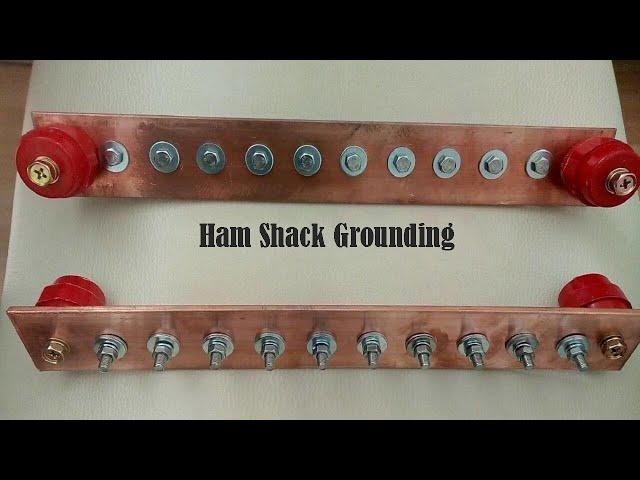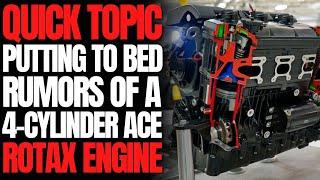Комментарии:

Grounding your Shack is more important than you think. Please share your thoughts about this topic by leaving a comment below.
Ответить
As an electrician, your grounding looked really really good..... until you got to the #8 termination point in the exterior box. I would take that wire from under that bolt head then drill and bolt a ground lug on that bar. Good job!
Ответить
Today this popped up in my feed, so I watched. I did not see your single point ground and bonding to the service panel ground. I did see mention of antenna ground as well in the comments and that too should be incorporated into your grounding package. I understand that every QTH has different grounding needs and the ways to get it done vary but it is extremely important to get it right. I wound up buying 315ft 6g bare copper and an 5 additional 8ft ground rods to bond my shack, antenna, and service panel ground. Also where feedline comes from antenna is a Times Microwave Mid-span Coaxial Grounding Kit.
Ответить
All good... NFPA/NEC requires that station ground also be bonded to mains ground. NEC 810.
Ответить
I love love love black beauty Cord Geip Busings for Weather proof electrical box connectors they can be ordered in various sizes for electrical box entry and provide chaffing protection. On your bond wire I would recommend a Chair lug or TA lug it provides a better mechanical connection to your ground Buss. And to meet current codes at least on the National Electrical Side bonding your shack grounds (technically Bonding) but those need to be attached (in an approved means) to your electrical System bonding. But any effort is good effort for safety and noise. 😊😊😊😊
Ответить
After losing a radio shack years ago due to a lightning strike of a tree in the back yard and the lightning traveling through the ground and up through my ground rod I will never again install a ground on my radios. They are grounded through the electrical outlet and the NEC manual specifically shows that those types of items are not to be grounded. Because mine was grounded against National Electric Code requirements, the insurance was able to get out of paying for the damage. Grounding ham radio equipment in your shack is a myth left over from the late 19th century when electronics were different than they are today, and house wiring was different than it is today, and the myth just wont die.
Ответить
NEC is the Bible on electrical grounding, and "grounding" outside of NEC guidelines can be dangerous. If your equipment has issues with electrical shock, then you need to make sure your equipment is functioning properly and that your shack electrical wiring is up to code. Your ground rod is actually not up to code and a violation. You're actually inviting lighting into your shack.
Ответить
From what I understand about the grounding rod, it needs to be bonded to the grounding rod of the house so there’s no difference in resistance. That is the general consensus anyway.
Ответить
Unfortunately it is a myth to think that connecting a station ground to a ground rod outside the shack is a good idea. If lightning didn't exist, MAYBE. But lightning does exist. And if a strike is close enough, the voltage from the strike travels into the ground up the ground rod and into your shack, likely frying everything connected to it. Ground is not equivalent to as place where lightning goes to die. The ground can and does get charged when struck by lightning, and connecting your radio and ham gear to it increases the danger dramatically. Lesson? Disconnect any buss bars that may be connected together inside the shack from the exterior "ground rod." Think of it this way: certain appliances come with a third wire (the green, for ground) so that it is properly grounded. In the olden days of ham radio, they weren't. What may have been necessary then (to eliminate charging the chassis of that old radio) is unnecessary today. Your ham rig IS grounded if it has a 3-prong plug. What is true for the garden variety appliance is equally true for the rig. Unless you know of an appliance that requires a ground rod being banged into the ground out the nearest window. I sure don't. If one thinks of the logic and physics of it, it really is simple. Now...RF grounding is another animal. BUT, none of these problems were ever solved (or could be) by running a ground wire from anything to an outside ground rod. First of, running a wire creates an antenna, therefore making any problem worse. Far better to put one's energy into ferrite chokes to resolve RFI than messing with "grounding." This old wive's tale needs to be put to bed. The mixup lies in the wording in the NEC code (that "equipment" must be grounded). That doesn't translate into running ground rods to everything that one plugs into an outlet. Why do ham rigs have a "grounding" post? Because the myth perpetuated over time. It is in the vast majority of cases unnecessary and actually causes more harm (from lightning, RFI and "ground loops") than any benefit that could derive from it. I live in FL. Lightning is not DIRECTABLE or CONTROLLABLE.
Ответить
Do you ground to the house ground via the third prong?
Ответить
looks ok so far. yes 2nd 8Ft UL ground rod is a great idea. yes 8 ft apart. should use #4 stranded bare wire between rods and up to your ground bar. ground current is on the surface of the wire. stranded wire is more area . also use ^ 6 or larger copper stranded wire out side you home and go to electric service ground rod and all ground rods be bonded together ! out side your home. when a surge happens it will be kelp outside and the same potential . If you have ground rod resistance meter the NEC is 25 ohms max for house ground, now RCA puts antenna ground at 10 ohm MAX . this will very to your type of ground. bond all ground rods together and out side burry the bare wire use UL approved ground clamps. they are the acorn type sold at Lowes home depot ETC. The clamp you have on your rod is for cold water pipe or gas pipe. a UL ground rod clamp makes a better connection as has lower resistance. When buying UL 8Ft ground rod ask for the UL ground rod clamp. you can look this up online so you know what to look for. it will be all copper or brass and have UL stamped right on it. If need more than 1 wire under the clamp use more clamps. on the same rod. the outher thing to have is surge protection for the AC power. as of 2020 the NEC requires a whole home surge protector in each breaker panel . and can be put in on older homes . just need a blank spot in breaker panel . then get a good surge protector strip and put it right at where you plug in. look for a good one that is UL listed . looking good so far. the ac ground on your home is for shock protection . I gone as far as GFCI outlets in my radio room (MAN CAVE) ham shack ETC. 73's
Ответить
All good comments. However, I'm 65 and have never had lighting strike any of my houses.
Ответить
The white coaxial cable should also have a lightning/static discharge suppressor on it.
Ответить
Very helpful. Where did you get your outside box? What is it listed/called on Amazon, so I can look up there or at an electric supply store? Thanks so much! Ben, N4UTX.
Ответить
Start first 8' ground rod go six feet install 2nd 8' ground rod.
Ответить
About 5 years ago lightning struck a large tree near my home. I had an elevated vertical with elevated radial wires, one of which was tied to the tree. The radial wire was vaporized and the surge current came into my shack on the braid of the coax feedline, looking for a ground. My transceiver was all hooked up and plugged in, with the feedline connected through a three position coax switch. The switch was in the center "grounded" position, but the surge current to ground was so large it destroyed the switch and damaged my transceiver. Now at all times, except when operating, my feedlines are completely disconnected (in the shack), the AC utility power & ground is disconnected from all equipment by way of a large, manually operated contactor, and the equipment ground bus is open from the outside ground rod by a huge copper knife switch. The equipment is connected to nothing. K4ATX
Ответить
This is a rare and very good video because you are showing the actual connections. Most videos only talk about theory.
adding this to my list.
Can you please show the grounding of your antennae?

Thanks for the information
Ответить
Great shirt!
Ответить
To get the Maximum benefit from driven rod electrodes they need to be driven the sum of their lengths apart. 8 foot rods are driven 16 feet apart, 10 foot rods are driven 20 feet apart, 1 10 foot rod and one 8 foot rod would be driven at least 18 feet apart, and so on.
Tom Horne

All ground straps should be also solder to each connection to
Ответить
You didn't mention the fact that any ground like you have must be bonded to the power company's ground. That is a NEC requirement. Without it your otherwise excellent ground is a hazard because it allows a potential difference to exist inside your house between your ground and the power line ground, and therefore surge currents will flow INSIDE your house.
This is serious. de K2XT

Thank you for the good explanations and the great pictures that help immensely. So I see how the interior equipment is grounded. Is the lightening arrestor and coax connected to the same box? In the event of strike or near strike wouldn't that bring that charge into the house. Some pictures of the antenna system and the grounding of the antenna would be of help. So many videos explain what they do without showing the actual connections and parts used which leaves myself confused I'm sorry to say. Also a parts list of be of great help. Thanks again for the explanations and visuals.
Ответить
You should put some grommets on the KO's on the outside box
Ответить


























